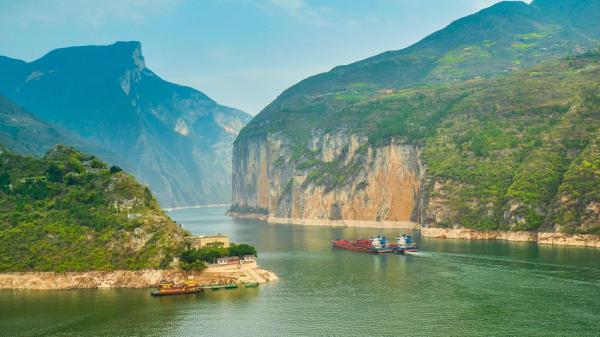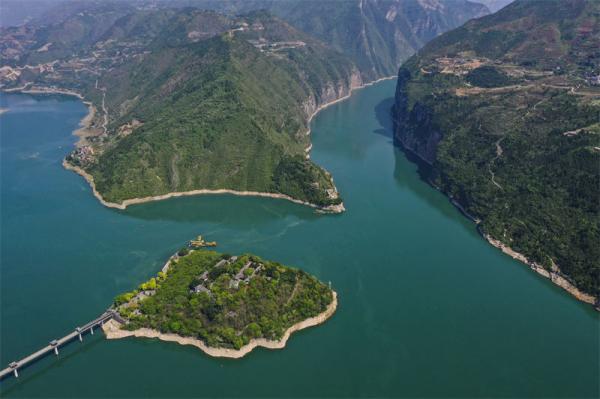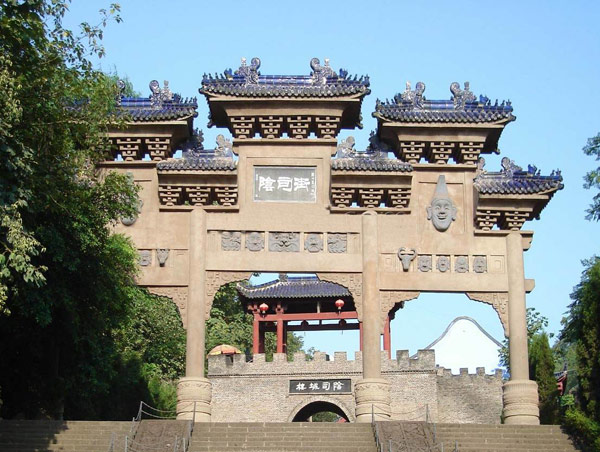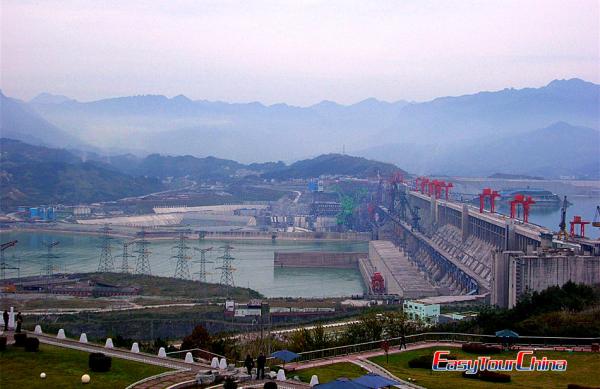Three Gorges: Wu Gorge, Qutang Gorge and Xining Gorge
The dramatic scenery and rushing waters of the Yangtze river have been inspirational to many of China's painters and poets. The most impressive section of the river is the three Yangtze River gorges: the Qutang Gorge, Wuxia Gorge and Xiling Gorge, collectively known as the Sanxia, or Three Gorges.
The Three Gorges of the Yangtze River is one of the top ten cultural symbols of Chongqing. The Three Gorges of the Yangtze River - Kuimen is the scenic pattern on the back of the 10-yuan banknote of the fifth set of Chinese currency.
What is the Three Gorges & Where is located
The Yangtze Three Gorges is a great valley with a most splendid landscape in the Yangtze (Changjiang) River and it is one of the ten most famous scenic sites of China . It extends from White Emperor City in Fengjie County, Chongqing Municipality to Nanjin Pass in Yichang, Hubei Province, consisting of Qutang Gorge, Wu Gorge and Xiling Gorge, which converges the essence of the scenery on the Yangtze River, with a full length of 193 km.
The Yangtze Thre Gorges presents a scene of boundless variety with the magnificence of Qutang Gorge ( 8 km =5 miles), the elegance of Wu Gorge ( 42 km =25 miles), the perilousness of Xiling Gorge ( 76 km =41 miles) as well as the primitive simplicity and the mysteriousness of the Daning River, Xiangxi stream and Shennong Stream, which flow into the great valley. The whole landscape is so kaleidoscopic. It is picturesque everywhere, and what more, each scene is related to a wonderful fairy tale or a moving legend which will kindle your meditation on the remote past.

Quick Fasts about Three Gorges
Qutang Gorge (瞿塘峡)
Qutang Gorge, the first of the three Yangtze Gorges, runs eight kilometers from Baidicheng (White Emperor City) in Fengjie County in the west to Daxizhen in Wushan County, Chongqing City. It is best known for its steep precipices that form an enormous gateway over the river. With only 8 kilometers (5 miles) long, Qutang Gorge is the shortest and narrowest but also the most spectacular of the Three Gorges. The widest point measures only 150 meters (500 feet) wide. The mountains on either side reach as high as 1200 meters (4000feet). This combination of narrow canyons among high mountains with several switchbacks in only 8 kilometers creates spectacular vistas, and the Qutang Gorge is often considered the most beautiful of all the Three Gorges.
White Emperor City
Located on the north bank of the Yangtze River at the mouth of the Qutang Gorge, atop Baidi Mountain. During the late Western Han Dynasty, Gongsun Shu occupied Sichuan and built a city on the mountain. Since a well within the city frequently emitted white mist, resembling a white dragon, he adopted the title of “White Emperor” and named the city Bai Di City (White Emperor City).
White Emperor City features multiple city gates, with a combined length of nearly 7,000 meters. The Southern Song Dynasty city walls span approximately 3,900 meters and are constructed of rammed earth and stone. The White Emperor Temple within White Emperor City features Ming and Qing-dynasty structures such as the Mingliang Hall, the Wu Hou Shrine, and the Star-Gazing Pavilion. It houses artifacts unearthed since the Neolithic era (including painted stele inscriptions, pottery, and bronze money trees) as well as calligraphy and paintings by renowned artists throughout history of China.
>> Recommended 8-day Chongqing Zhangjiajie Tour with Yangtze River Cruise
Chongqing Kuimen
Located at the mouth of Qutang Gorge in the Three Gorges of the Yangtze River, it is the western gateway to the Three Gorges. Rising abruptly from the ground, its twin peaks seem to converge, forming a half-open gate, hence the name Kuimen. Together with Jianmen (Gate of Sword), Emei Mountain, and Qingcheng Mountain, it is known as one of the four famous scenic spots of Bayu (ancient Sichuan).

Wu Gorge (巫峡)
When the river flows out of Qutang Gorge and passes the broad valley of the Daning River, it enters the scenic Wu Gorge. Wu Gorge is home to the famous 12 peaks of the Wushan Mountains. It’s 45 kilometers long, extending west to east from the mouth of the Daning River in Wushan County to Guandukou in Badong County, Hubei Province. Noted for its deepness, serenity and elegance, Wuxia Gorge is full of zigzag, weird peaks, rising mists and beautiful sights. The famous Twelve Peaks on both banks of the river, in particular, are the most spectacular. Among them, the most fabulous is the Peak of Goddess. It pierces through the heaven, and towers over the Yangtze River.
The Twelve Peaks of Wushan, Chongqing
The two banks of the Wu Gorge are flanked by the Twelve Peaks of Wushan, which run from west to east as follows: Denglong, Shengquan, Chaoyun, Shennü, Songluan, and Jixian. There are also six peaks on the south bank, but only three of them are visible from the river: Feifeng, Cuiping, and Juhé. The remaining three peaks, Jingtan, Qiyun, and Shengsheng, do not face the river. The Wu Gorge is named after these twelve peaks.
Goddess Peak
Goddess Peak is the most famous of the Twelve Peaks of Wushan. On the peak stands a slender stone pillar resembling a graceful young maiden. Legend has it that the youngest daughter of the Western Queen Mother, Yaoji, traveled to the East Sea and passed through Wushan. Seeing the rampant floods, she stood on the mountain peak for an extended period to pray for a bountiful harvest, eventually transforming into Goddess Peak.
The Lesser Three Gorges
The Lesser Three Gorges are composed of Longmen Gorge, Ba Wu Gorge, and Di Cui Gorge, which are formed by the lower reaches of the Danning River flowing through the Wushan region. They are adjacent to the Three Gorges of the Yangtze River.
Xiling Gorge (西陵峡)
As the longest gamong the Yangtze Three Gorges, Xiling Gorge stretches west to east for 76 kilometers from the mouth of the Xiangxi River at Zigui in Hubei Province to Nanjing Pass near the city of Yichang in Hubei. It is divided into the west section and the east section with each consists of several small unique gorges. Along Xiling gorge sit many archeological sites, including the Huangling Temple, first built during the Three Kingdoms Period (220-280). In addition, the Three Visitors' Cave and the Luyou Fountain all have their unique features.
Xiling Gorge is known for its hidden reefs, perilous cliffs and tumbling rapids, as well as the orange groves and tea plantations on its shores. At some points there are treacherous whirlpools and the waters are extraordinarily turbulent.

Fengdu Ghost City
Fengdu County is known as the hometown of the Divine Comedy and one of the 72 sacred sites of Taoism. It is an ancient city that blends Ba-Yu traditional culture with ghost culture. Fengdu Ghost City is famous worldwide for its “Underworld,” said to be the final resting place of human souls. Today, it serves as a treasure trove of folk cultural arts integrating Confucian, Buddhist, and Taoist traditions, and is also one of the shore excursions for Yangtze River cruises.
>> Recommended Impressive China Tour: Tibet & Yangtze Cruise
Shibaozhai Pagoda
It is the largest and tallest timber-frame structure in China, with twelve stories and a total height of 50 meters, built against Yuyin Mountain.
Wanzhou Waterfall
Located 287 kilometers from Chongqing's main urban area, it rivals the Huangguoshu Waterfall in grandeur.
The Goddess Stream
The landscape is breathtaking. The five peaks—Cui Ping, Fei Feng, Qi Yun, Sheng Shang, and Jing Tan—are scattered along both sides of the river.
Three Gorges Dam
The Three Gorges Project involves the construction of a dam, which is the largest hydroelectric project in the world. The under-construction Three Gorges Dam is 2km/1.25mile long and 185m/600ft high with the generating capacity of 16 nuclear power stations, capable of generating 18 gigawatts of hydroelectric power. As well as supplying electricity the dam will provide water for irrigation and enhance flood protection. The dam is estimated to cost $29 billion, and scheduled for completion in 2009.
The beautiful landscape of the gorge region has given birth to a splendid culture. It is one of the birthplaces of the civilizations of China. The famous Daxi Culture, which originated here, has shed brilliant light on the civilizations in the long history. The valleys were once the battlefields during the period of the Three Kingdoms, where countless heroes displayed their bravery and talent. Besides, a great many well-known historical sites such as White Emperor City, Huangling Temple and Nanjin Pass, add charm to the landscape.

Three Gorges Museum
The museum tells the story of how billions of years of marine and terrestrial sedimentation created the unique landscape of the Three Gorges region of the Yangtze River. Listen to the ancient history and culture of the Yangtze River, its myths and legends, and the magnificent poems that have been passed down through the ages. Learn about the magnificent Three Gorges Dam project and the spirit of the Three Gorges immigrants. In addition, discover Ba-Yu bronze ware, Han Dynasty artifacts, and artifacts of the ethnic minorities of Southwest China.
>> Recommended 2-day Chongqing Highlights Tour
Chinese Food of the Three Gorges
The cuisine of the Three Gorges region of the Yangtze River mainly consists of Chinese food from Chongqing and Yichang in Hubei Province, such as Chongqing hot pot, small noodles, spicy hot pot, bean curd fish, steamed or braised Yangtze River fish, and Yichang sauce duck.
Weather & Best time to visit Three Gorges
The Three Gorges are located in the subtropical humid monsoon climate zone. In spring (March - May), there are frequent light rains and the clouds and mist create a misty atmosphere. The Three Gorges resemble an ink painting and it is a great time for tourism. In autumn (September - November), it is sunny and has little rainfall, making it the best tourist season. From the end of October to November, the red leaves in the Three Gorges reach their peak, among which the Goddess Peak in Wu Gorge is the most beautiful.
>> Recommended 10-day Expedition of Yangtze River
How to Get There
Take a Yangtze River cruise: the best way. You can cruise Yangtze River from Chongqing to Yichang (downstream), Yichang to Chongqing (upstream), or Chongqing to Shanghai (long route).
You can also choose to take a bus from Chongqing Longtou Temple Bus Station to Wushan or Fengjie. Or you can take a bus from Yichang Bus Station to Zigui or the Three Gorges Dam.
>> Recommended 11-day China Tour for Seniors with Yangtze Cruise